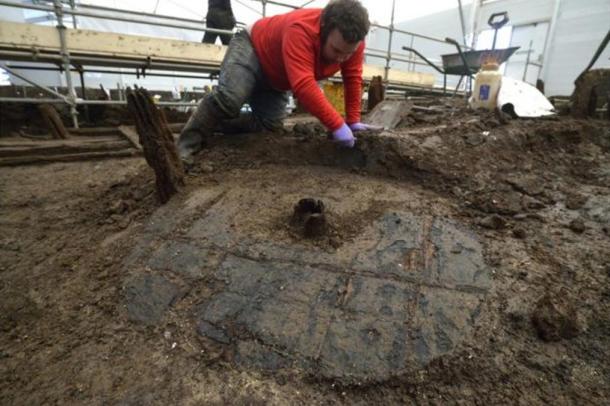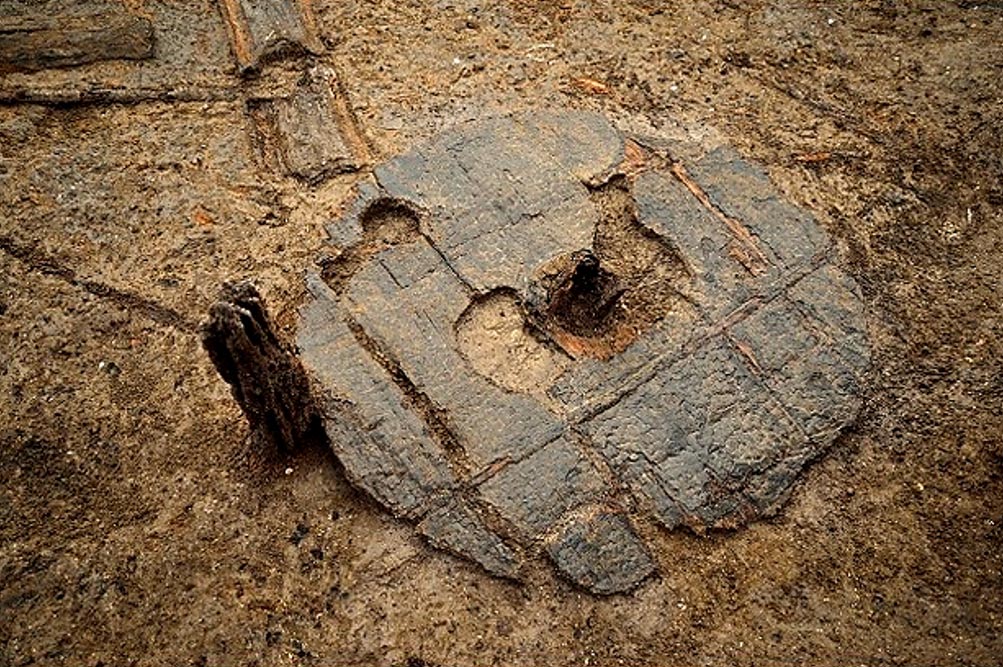Bronze Age Wooden Wheel Adds to List of Surprising Finds at Must Farm
At the Must Farm Bronze Age site in England archaeologists have now turned up a wooden wheel to add to other significant finds there, including vitrified food and well-preserved textiles, wooden platters, spears, knives, tools, and jewelry.
Archaeologists were excited about the find at the site, which is the best-preserved homestead of the Bronze Age in Britain.
Three Bronze Age dwellings were burned in a fire and collapsed from their stilts into a river below about 3,000 years ago. Some news reports call the site England’s Pompeii, but it has none of the spectacular stone-hewn architecture and dramatic tableaus frozen by the Italian volcano that erupted in 79 AD. However, researchers have found contents of the houses preserved in “astonishing detail” in the fen (a type of wetland). The houses themselves are among the best-preserved Bronze Age dwellings ever found in Britain.

Excavations at the Must Farm site. (David Rose/The Telegraph)
“This is the site I have been looking for all my life,” archaeologist Francis Pryor told the Guardian. “This was one of the most prosperous parts of Britain at this date. All the attention has gone to sites like Stonehenge, but they were on the periphery. Economically, this was where it was at.”
The team of archaeologists, led by Cambridge Archaeological Unit’s Mark Knight, are digging 2 meters (6 feet) below the surface of the ground. Three thousand years ago, that was ground level and at the river bed.
They have exposed charred roof timbers of a roundhouse, timbers with tool marks and a palisade of wooden posts that enclosed the settlement. The preservation of the site is so good that researchers have even found footprints of the prosperous people who lived there.
Researchers found the wheel, still attached to the hub, on a floor timber that they think was used in construction of one of the site’s houses. The wheel may have been hanging on a wall for repair, Mark Knight told the Guardian.
“My hunch is that 3,000 years ago there was a cart parked up on the dry land, with a wheel missing,” he’s quoted as saying.

The wheel was found close to one of the settlement's roundhouses. (Cambridge Archaeological Unit)
Archaeologists have been discovering how people in the late Bronze Age lived and what they ate by excavating the small, prosperous settlement, which is in Cambridgeshire County, England.
The settlement was buried in the wet fens but is being excavated using earth-moving machinery. Previously, archaeological work was done only in shallow areas or near the edges of the fens, says MustFarm.com. They call it “deep-space archaeology” because the remnants of the community are buried so deeply in the mire. MustFarm.com calls it one of the most important European Bronze Age sites.
- Houses from 3,000 Years Ago Are Among Best-Preserved of the Era in Britain
- Solved: the mystery of Britain’s Bronze Age mummies
- Bronze Age time capsule: 3,000-year-old vitrified food found in jars in England
- Ancient bog body found in Ireland may be Iron Age sacrifice
Must Farm in the Flag Fen Basin made news in 2011 when nine well-preserved log boats were unearthed there. The fact that it was submerged helped preserve its contents, according to Culture24. Among the findings from previous excavations are decorated tiles made from lime tree bark.
Though the houses were built just above the river, the people who lived in them seem to have ignored the water fowl, fish, and eels just below them, says the Guardian. Instead, traces found at the site show they were eating grains, lamb, beef, pork, and venison. The researchers think they had many domesticated animals on nearby dry land or connections with local communities.

Some of the pots discovered in the archaeological dig at Must Farm Quarry in Cambridgeshire. (Dave Webb/ Cambridge Archaeological Unit)
The log boats seem to imply their main method of transportation was by boat, but the recent find of the wheel (combined with a past discovery of a horse’s spine) shows they may have also used carts drawn by animals.
The researchers have said the site ranks with other important prehistoric wetland sites, including the loch-side dwellings known as crannogs in Ireland and Scotland; stilt houses around the Alpine Lakes; and the terps of Friesland, manmade hill dwellings in the Netherlands.
Featured Image: The wooden wheel unearthed at Must Farm. Source: Cambridge News
By Mark Miller


















Comments
Did people find any symbols / patterns / characters etc. on these artifacts?